Drake G.W.F. (editor) Handbook of Atomic, Molecular, and Optical Physics
Подождите немного. Документ загружается.

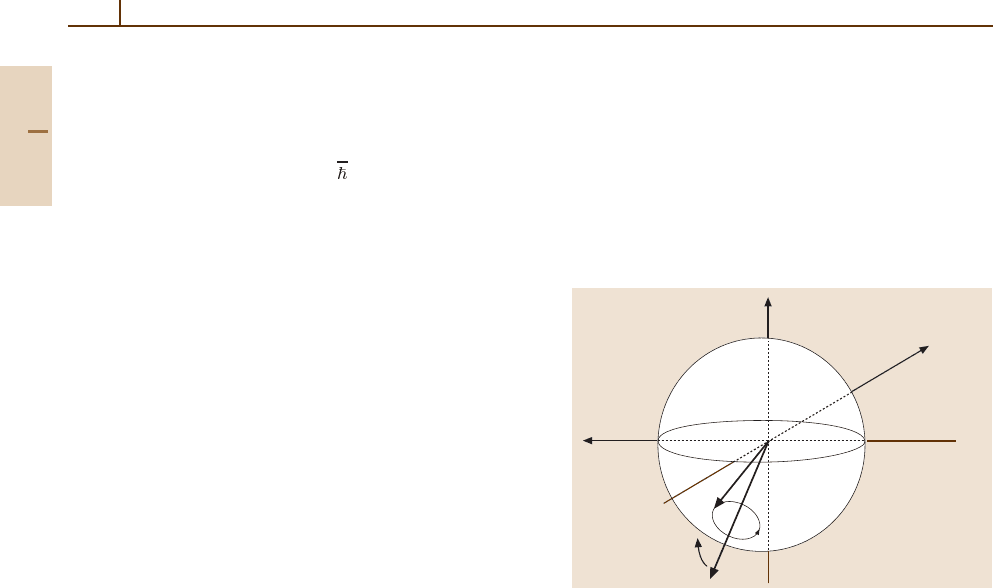
1068 Part F Quantum Optics
a rotation of the Bloch vector in the V –W plane. The
angle θ is called the pulse area, defined by
θ(t) ≡
t
−∞
dt
Ω
1
(t
) =
d
t
−∞
dt
E (t
). (73.8)
The area under the envelope of the Rabi frequency is
thus the same as the angle through which an exactly-
resonant Bloch vector turns due to the pulse. If θ = π,
the atom is driven from the ground state exactly to the
excited state. This is “π-pulse” inversion. A “2π-pulse”
takes the atom from the ground state through the excited
state and back to the ground state. For ∆ =0, the Bloch
vector rotation angle does not depend upon the shape of
the field pulse, only on the area of the pulse.
73.3.4 Adiabatic Following
The Bloch vector picture is used for semiquantitative
predictions. These are reliable even if ∆ and Ω
1
are
time-dependent, if the parameters change slowly (adia-
batically). For example, if Ω is moved slowly the Bloch
vector follows closely. It is possible to achieve complete
inversion smoothly in this way. If the field is initially
tuned far below resonance so ∆ Ω
1
then Ω points ap-
proximately toward the south pole of the Bloch sphere.
As shown in Fig. 73.3, the Bloch vector then precesses
in a very small circle about the torque vector. If the field
frequency is now slowly changed (chirped) so that ∆
goes from a large negative value to a large positive value
then every atomic Bloch vector will continue to precess
rapidly around the torque vector, and follow it as it pro-
ceeds from pointing straight down to pointing straight
up. In this way the population is transferred between the
two levels.
W
–V
–U
U
Fig. 73.3 In adiabatic inversion the Bloch vector of each
atom precesses in a small cone about the torque vector as
the torque vector goes from straight down to straight up
73.4 Inhomogeneous Relaxation
The fact that the various atoms in a sample may have dif-
ferent resonance frequencies produces a number of novel
phenomena. Given a distribution g(∆) of detunings in
a dilute gas of density N, the macroscopic polarization
can be written
P(t) =−Nex(t)
= Nd
g(∆) Re
(U −iV ) e
−iωt
d∆,
(73.9)
where U −iV generally depends on both t and ∆.
73.4.1 Free Induction Decay
Free induction refers to evolution of the polariza-
tion in the absence of a laser field. For Ω
1
= 0,
the Bloch vector of an atom with ∆<0 precesses
counterclockwise in the U–V plane. In a macro-
scopic sample, there are many values of ∆ and about
as many are positive as negative. Thus an oriented
collection of Bloch vectors, all pointing in the V di-
rection at t = 0, will rapidly fan out in the U–V
plane due to differing precession rates, and after
a short time the net V value will be zero, as will the
net U value. This is free induction decay (FID)of
polarization.
More precisely, if all atoms are first exposed to a θ
0
pulse, so that at t = 0
U(0,∆)= 0 ,
V(0,∆)=−sin θ
0
, (73.10)
W(0,∆)=−cos θ
0
,
then if E = 0fort > 0, an individual atom with detuning
∆ evolves according to (73.4):
U −iV = isinθ
0
e
−
(
1/T
2
−i∆
)
t
. (73.11)
The macroscopic polarization is found by summing the
individual (U −iV ) values over the detuning distribution
g(∆).
For simplicity, in this subsection we will ignore
competition from homogeneous decay (take 1/T
2
≈ 0)
Part F 73.4
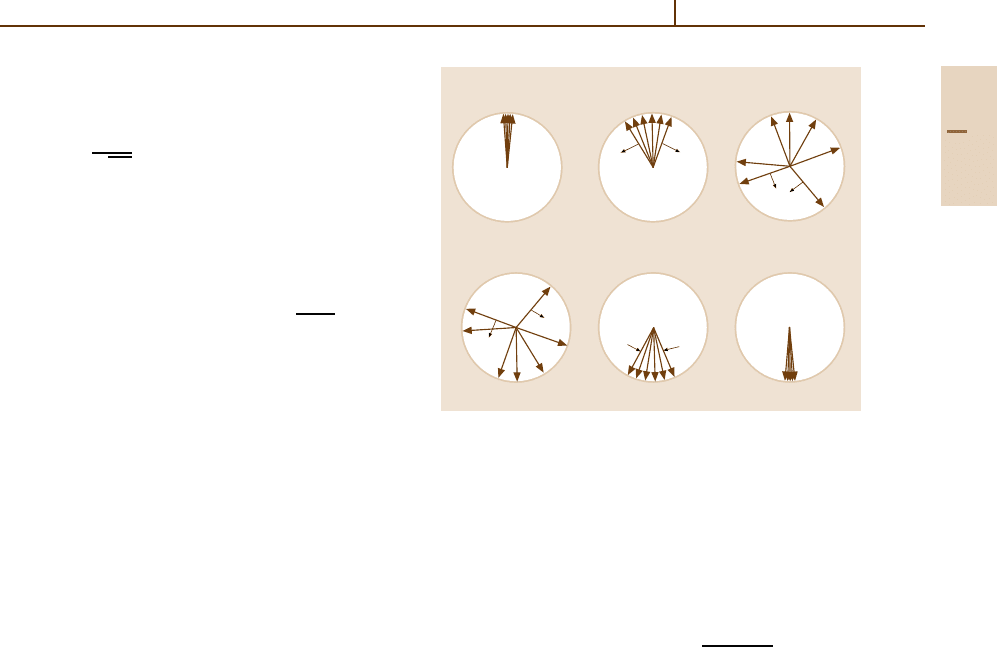
Coherent Transients 73.5 Resonant Pulse Propagation 1069
and assume the most common inhomogeneous lineshape
(i.e., Doppler-Maxwellian):
g(∆) =
T
∗
√
2π
e
−(∆−∆
0
)
2
T
∗2
/2
, (73.12)
where 1/T
∗
is here defined as the width (standard devi-
tation) of the Doppler distribution and ∆
0
is the detuning
of the zero-velocity atoms. The collective result is
P(t)=Nd sin θ
0
sin ωte
i∆
0
t
exp
−
t
2
2T
∗2
.
(73.13)
The detuning “inhomogeneity” in the sample leads
to dephasing of the collective dipole moment, and
the inhomogeneous relaxation time is obviously T
∗
.
This is illustrated by the decrease of collective align-
ment of Bloch vectors in the top row of Fig. 73.4.
For a typical room temperature gas a visible transi-
tion has a width given by 1/(2πT
∗
) ≈ 1.5 GHz so that
T
∗
≈ 10
−10
s.
73.4.2 Photon Echoes
A photon echo is generated by pulse-induced recovery
of a nonzero P(t) after P(t) → 0 due to free induction
decay (FID). This analog of the spin echo effect is pos-
sible because each atom retains its own detuning for
a relatively long time, usually up to an average collision
time T
2
.
During FID,theU–V projection of every atom’s
Bloch vector precesses steadily clockwise or counter-
clockwise depending on the sign of its ∆. Thus the
Bloch vectors could be rephased if they could all be
forced at the same moment to reverse their relative sense
of precession. The prototypical echo scenario has FID
beginning at t = 0, with P(t) → 0fort T
∗
, followed
by a π–pulse at the time t
,wheret
T
∗
. The effect
of the π-pulse is to reverse the sign of V and W [re-
call (73.10)], in effect flipping the equatorial plane of
the Bloch sphere upside down. Thus for t t
we have
Bloch vectors fanning back together. The macroscopic
Free induction decay – dipoles dephase
After π pulse – dipoles rephase
t = 0 t = t– ε
t = t + ε
t = 2t
A
B
B
A
A
A
B
B
Fig. 73.4 The ensemble of dipole moments spreads due to
the distribution of resonance frequencies. The distribution
of Bloch vectors in the U–V plane is shown at various times
after the initial short pulse excitation. By the time t
,the
dipoles have spread uniformly around the unit circle. A π-
pulse then flips the relative orientation of the dipoles so that
they subsequently rephase
polarization obeys
P(t) = Nd sin θ
0
sin ωt exp
−
(t −2t
)
2
2T
∗2
e
−t/T
2
,
(73.14)
where the last factor recovers the effect of homogeneous
dipole damping. We require T
2
t
T
∗
for a strong
echo signal in the neighborhood of t = t
.
The result is illustrated in Fig. 73.4. An “echo” of
the initial excitation at t = 0 appears at the time t =
2t
. After this, FID occurs again, and this second decay
can also be reversed by applying another π–pulse, and
so on, until t ≈ T
2
, at which time the inevitable and
irreversible homogeneous relaxation cannot be avoided.
The scenario of π–pulse reversal is only the most ideal,
leading to the most complete echo, and other pulse areas
will also lead to echos; a more important factor is that
the reversing pulse must be short enough that negligible
dephasing takes place during its application.
73.5 Resonant Pulse Propagation
73.5.1 Maxwell–Bloch Equations
Time-dependent atomic dipole moments created by ap-
plied fields are themselves a source of fields, another
form of coherent transient. We limit discussion to plane-
wave propagation in the z–direction. Note that we use z
rather than Z for convenience, although in the dipole ap-
proximation the coordinate entering our equations is the
Part F 73.5

1070 Part F Quantum Optics
coordinate of the center of mass of the atom rather than
the internal electron coordinate. The field is generalized
from (73.2)to
E(t, z) =
1
2
E (t, z) e
i(Kz−ωt)
+c.c.
, (73.15)
and the macroscopic polarization is the correspondingly
generalized form of (73.9):
P(t, z) = Nd
g(∆) Re
(U −iV ) e
i(Kz−ωt)
d∆.
(73.16)
The difference between K and k =ω/c indicates that the
refractive index is nonzero. The traveling-pulse rotating
frame is also obtained by replacing ωt by ωt − Kz.
If the field envelope E is slowly varying, its second
derivatives can be dropped when E(t, z) is substituted
into Maxwell’s wave equation. The resulting dispersive
and absorptive reduced wave equations are
K
2
−k
2
E = 4πk
2
Nd
×
g(∆)U(t, z,∆)d∆,
(73.17)
K
∂
∂z
+k
∂
∂(ct)
E = 2πk
2
Nd
×
g(∆)V(t, z,∆)d∆.
The Bloch equations along with these reduced wave
equations form the self-consistent Maxwell–Bloch
equations that are used to treat most resonant propaga-
tion problems in quantum optics and laser theory [73.1,
2, 5, 8].
73.5.2 Index of Refraction and Beers Law
If a weak pulse of duration τ propagates in a medium
of ground-state atoms (W ≈−1), the Bloch equations
have simple quasisteady-state solutions (τ T
2
)
U =
Ω
1
∆
∆
2
+1/T
2
2
,
V =
−Ω
1
/T
2
∆
2
+1/T
2
2
. (73.18)
When U and V are substituted back into the reduced
wave equations (73.17), the dispersive equation gives
the index of refraction n = K/k due to the ground-state
atoms:
n
2
−1 =
4πNd
2
∆g(∆)
∆
2
+1/T
2
2
d∆, (73.19)
and the absorptive equation predicts steady state field
attenuation during propagation:
∂
∂z
E =−
1
2
α
B
E . (73.20)
The constant α
B
given by
α
B
=
4πNd
2
ω
cT
2
g(∆)
∆
2
+1/T
2
2
d∆ (73.21)
is called the extinction coefficient, or the reciprocal
Beers length.
Since field intensity I is proportional to E
2
,the
solution to the absorptive equation is
I(z, t) = I(0, t) e
−α
B
z
. (73.22)
This relation is called Beers Law. Both the disper-
sive and absorptive results are familiar from classical
physics [73.10], with the important distinction that
here the
-dependent oscillator strength enters naturally
rather than as an empirical parameter from Lorentzian
dielectric theory [73.8, 10].
73.5.3 The Area Theorem
and Self-Induced Transparency
A form of pulse propagation with no classical analog
arises in the short-pulse limit (τ T
2
, T
1
,butτ T
∗
2
).
By integration over the entire pulse, the absorptive
Maxwell equation becomes an equation for ∂θ/∂z,where
θ is the pulse area defined in (73.8). In the short-
pulse limit, the relaxation terms in the OBEs can be
ignored and when substituting from them we obtain the
McCall-Hahn Area Theorem [73.1]:
∂
∂z
θ(z) =−
1
2
α
B
sin θ(z). (73.23)
This predicts the same exponential attenuation as (73.20)
in the case of a small area pulse, θ(z) π, but in the
case of larger area pulses the behavior is quite different.
In general, the area decreases during propagation for
areas in the range 0 <θ(z)<π, but it increases for areas
π<θ(z)<2π.AsseenfromFig.73.5, this change of
area with propagation causes the pulse area to evolve to
one of the stable values 0, 2π, 4π,... .
There is one special pulse, a soliton solution with
area exactly 2π, which propagates without shape change
in the short pulse limit, given by
E (t, z) =
2
τd
sech
t −z/v
τ
,
(73.24)
where τ is the pulse duration, which is arbitrary but must
satisfy the short-pulse inequality τ T
1
, T
2
. The soli-
ton’s group velocity is determined by the corresponding
Part F 73.5
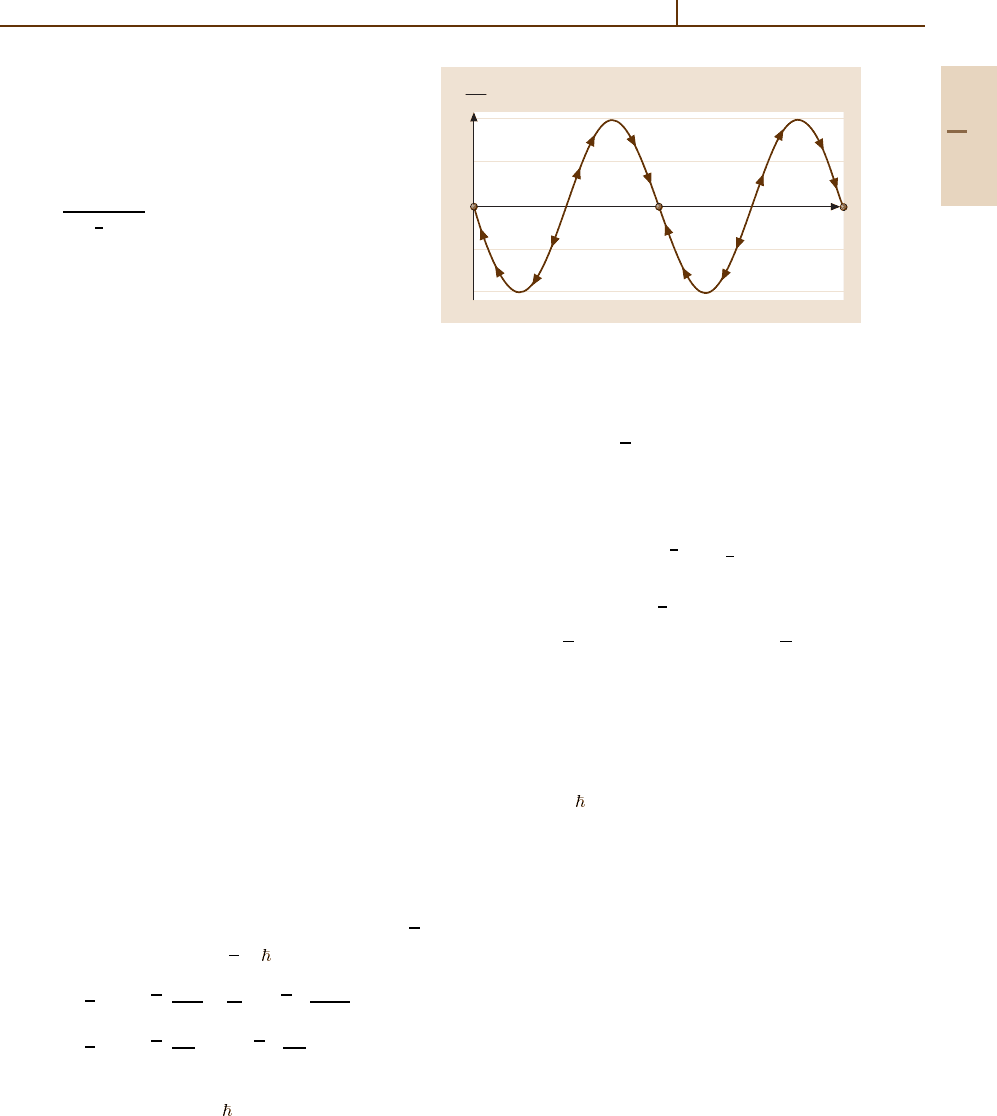
Coherent Transients 73.6 Multi-Level Generalizations 1071
Fig. 73.5 McCall-Hahn area theorem for an absorbing
medium. On propagation the area of the pulse will follow
the arrows toward one of the stable values, 0, 2π,4π, ...
soliton solutions to the OBE’s and the dispersive
v =
c
1 +
1
2
α
B
cτ
,
(73.25)
where α
B
is to be taken in the limit T
∗
2
T
2
. The group
velocity can be slower than the speed of light by orders
of magnitude if α
B
cτ 1.
0
π
θ
δθ
δz
2π 3π 4π
73.6 Multi-Level Generalizations
73.6.1 Rydberg Packets
and Intrinsic Relaxation
A short laser pulse can populate a band of excited states
whose probability amplitudes will exhibit mutual co-
herence. This single-atom coherence is transient, even
without collisions or other external perturbations to dis-
rupt it, and its decay can be called intrinsic relaxation.
The decay is basically a dephasing. The dipole moments
associated with the excited band interfere due to the wide
variety of resonance frequencies of the states in the su-
perposition. Because of the discreteness of the energy
levels of any bounded quantum system, this relaxation
has its own unique characteristics, including similarities
with both homogeneous and inhomogeneous decay.
The wave function for a coherently excited atom can
be expressed in the interaction picture in the form [73.9]
Ψ(r, t) = a(t)ψ
g
(r) +
n
b
n
(t)e
−iω
n
t
ψ
n
(r),(73.26)
where ψ
g
(r) is the ground state wave function, and n
labels the states in a band with excitation frequencies
ω
n
≈ ω.If|ω
n
−ω|ω
n
, the transition frequency ω
n
can be expanded about the principal quantum number n
of the resonant excited state E
n
= ω to obtain
ω
n
= ω
n
+(n −n )
∂ω
n
∂n
+
1
2!
(n −
n)
2
∂
2
ω
n
∂n
2
+···
= ω
n
+(n −n )
2π
T
K
+(n −n )
2
2π
T
R
+··· . (73.27)
Thus 2π/T
K
is the mean frequency separating neigh-
boring levels, i. e., T
K
/2π = ρ(E),whereρ(E) is the
density of excited states, and 2π/T
R
is the mean change
in this frequency separation. T
K
is the same as the Ke-
pler period a classical orbit, and T
R
is the revival time.
Substituting the Bohr frequencies into the definitions for
T
K
and T
R
yields T
R
= nT
K
/3.
For times t ≤ T
R
the expansion can be truncated
after the third term. Then the wave function is given
approximately by
Ψ(r, t) ≈ a(t)ψ
g
(r) + e
−iω
n
t
m
b
n+m
(t)e
−i2πmt/T
K
×e
−i2πm
2
t/T
R
ψ
n+m
(r), (73.28)
where m = n −n. For high Rydberg states, n 1, the
time scales associated with the two exponentials inside
the sum are quite different. For times t T
K
the individ-
ual levels are not resolved, thus the laser excites what is
effectively a continuum with a density of states ρ(E).In
that case the ground state population simply decays ex-
ponentially at the rate given by first-order perturbation
theory, Γ = (2π/
)d
2
E
2
ρ(E). At longer times t ≈ T
K
,
the first exponential contributes, but the second does not,
giving a simple Fourier series time dependence. In this
regime the evolution of the wave function is just peri-
odic motion of a wave packet around a Kepler orbit, as
is illustrated in Fig. 73.6a.
The coherent quantum wave packet behaves like
a classical particle for many Kepler periods, gradu-
ally spreading out as the second exponential in the sum
(73.28) begins to contribute. This spreading of the wave
packet produces the intrinsic relaxation of the collective
dipole moments from the various transitions. However,
because the levels are discrete, this decay is not perma-
nent, but is reversed and leads to a spontaneous “revival”
of the original wave packet [73.6], without the need for
a π-pulse to produce an “echo.”
In its evolution toward the revival, the wave packet
passes through a number of fractional revivals in which
Part F 73.6
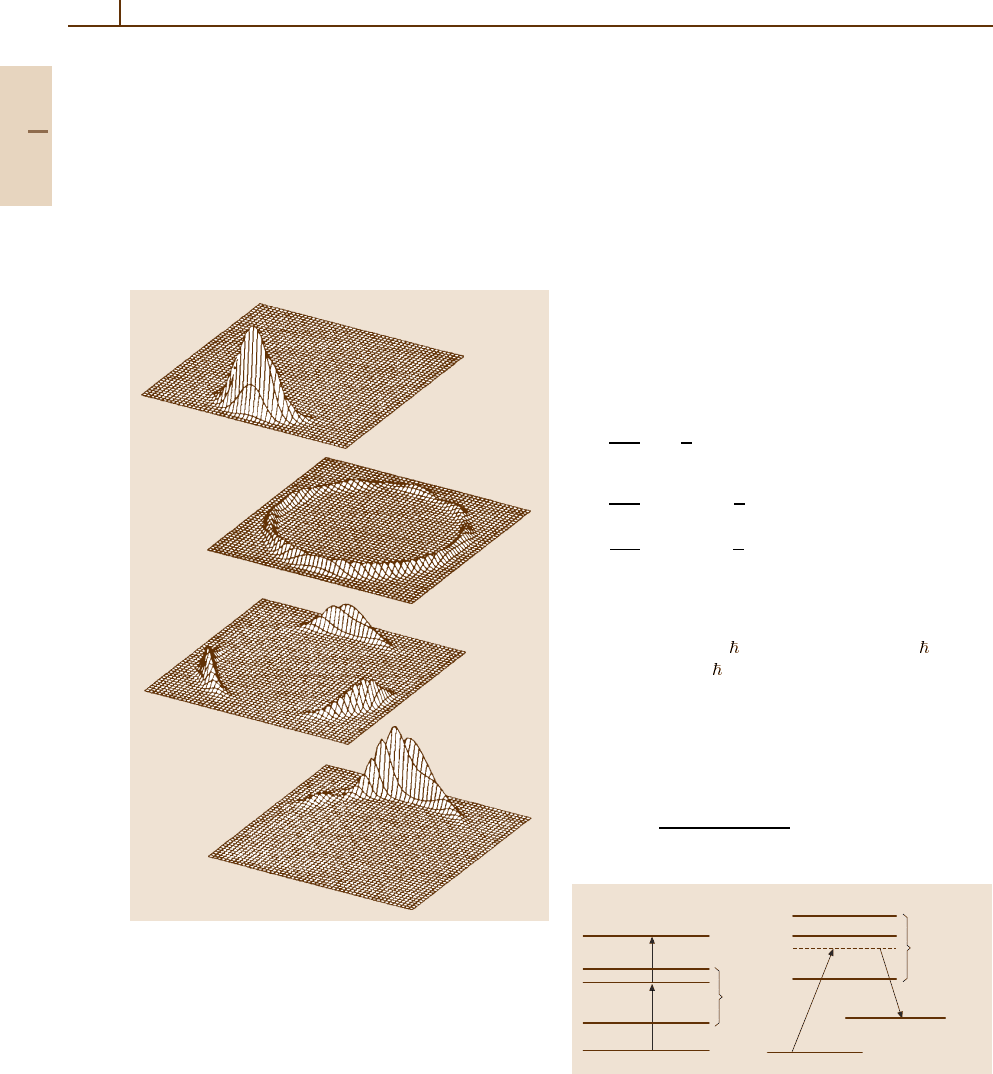
1072 Part F Quantum Optics
miniature replicas of the original wave packet are equally
spaced around the orbit, each traveling at the velocity
of a particle traveling in a corresponding classical Ke-
pler orbit. This complex time evolution arises from the
spreading of the wave packet all the way around the orbit
so that the head and tail of the packet interfere with each
other, producing interference fringes. The further evo-
lution of this fringe pattern produces the various revival
phenomena shown in Fig. 73.6.
a)
b)
c)
d)
Fig. 73.6a–d The free evolution of a Rydberg wave packet
made up of a superposition of circular-orbit states centered
about n = 360.
(a) Initially the wave packet is to good
approximation a minimum uncertainty wave packet in all
three dimensions, but after 12 orbits
(b) the packet has
spread all the way around the orbit so that the head and tail
of the wave packet overlap, producing interference fringes.
(c) After 40 orbits, t = T
R
/3, the fringes have produced
the one-third fractional revival in which three miniature
replicas of the original wave packet are equally spaced
around the orbit.
(d) After 120 orbits, t = T
R
, the complete
wave packet revival occurs
73.6.2 Multiphoton Resonance
and Two-Photon Bloch Equations
Multiphoton transitions Fig. 73.7a introduce new coher-
ent transient phenomena. If levels |g and |e have the
same parity, two photons from the same laser field are
sufficient to excite level |e. For simplicity we regard |e
as a single state, but any number of intermediate levels
|j of opposite parity may be present.
Substituting the state vector
|Ψ(t)=a
g
(t)|g+
j
b
j
(t)e
−iωt
|j
+a
e
(t)e
−i2ωt
|e , (73.29)
into the Schrödinger equation yields
i
da
g
dt
=−
1
2
j
Ω
gj
b
j
, (73.30)
i
db
j
dt
= ∆
jg
b
j
−
1
2
Ω
jg
a
g
+Ω
je
a
e
,
(73.31)
i
da
e
dt
= ∆
eg
a
e
−
1
2
j
Ω
ej
b
j
, (73.32)
where the ∆s are the detunings and the ΩsaretheRabi
frequencies for the dipole-allowed transitions. For ex-
ample, Ω
gj
= d
gj
E / ,and∆
jg
= (E
j
−E
g
)/ −ω and
∆
eg
= (E
e
− E
g
)/ −2ω.
If the states |j are not too close to resonance, the
b
j
oscillate rapidly and to a first approximation average
to zero. A better approximation is to retain the small
nonzero solution for b
j
obtained by setting db
j
/dt = 0
in (73.31) to obtain
b
j
=−
Ω
jg
a
g
+Ω
je
a
e
2∆
jg
, (73.33)
a) b)
ω
ω
e
j
g
ω
a
ω
b
e
g
j
Fig. 73.7a,b Model two-photon resonances. Two photons
couple the ground state |g with an excited state |e.Many
intermediate nonresonant levels |j are present. In
(a) we
have the cascade system, and in
(b) the Λ pump–probe
system
Part F 73.6
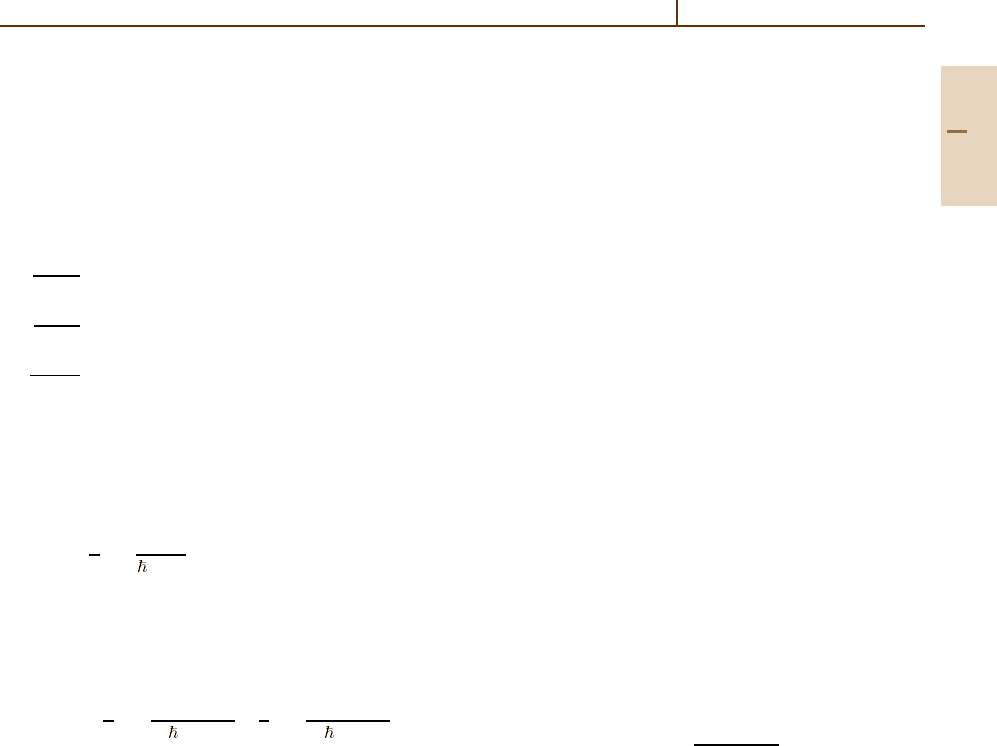
Coherent Transients 73.6 Multi-Level Generalizations 1073
which can be used to eliminate b
j
from the equations
for a
g
and a
e
. This is called adiabatic elimination of
dipole coherence. In this approximation, levels |g and
|e are directly coupled to each other and two-photon
coherence arises. The coupling of levels |g and |e is
similar to the two-level coupling described in Sect. 73.1
and two-photon Bloch equations analogous to (73.5)are
the result:
dU
(2)
dt
=−∆
(2)
V
(2)
,
dV
(2)
dt
= ∆
(2)
U
(2)
+Ω
(2)
W
(2)
,
dW
(2)
dt
=−Ω
(2)
V
(2)
, (73.34)
Here the superscript (2) indicates that the variables are
identified with the two-photon |g→|e transition.
The various coefficients are similarly general-
ized [73.11]. For example, the two-photon Rabi
frequency is given by
Ω
(2)
≡
1
2
j
d
gj
d
je
2
∆
jg
E
2
. (73.35)
and the two-photon detuning ∆
(2)
incorporates the laser-
induced level shifts
∆
(2)
≡ ∆
ej
+∆
jg
+
1
4
j
|d
ej
|
2
E
2
(t)
2
∆
ej
+
1
4
j
|d
jg
|
2
E
2
(t)
2
∆
jg
.
(73.36)
The last two terms give the difference in the ac Stark
shifts of the upper and lower levels produced by the
laser field.
W
(2)
is the inversion as before, but U
(2)
and V
(2)
are
somewhat different. They cannot be directly tied to the
expectation value of a dipole moment because levels |g
and |e have the same parity. Thus, while the quantity
U
(2)
−iV
(2)
is the two-photon analog of U −iV in the
original OBE’s, it cannot serve as a source term in the
Maxwell equation.
In the case of cw applied fields, the solutions to the
two-photon OBEs are formally identical to those for
a two-level atom. In the case of pulsed fields, how-
ever, the detuning ∆
(2)
(t) is automatically “chirped”
in frequency by the Stark shifts. This chirping may
significantly modify the dynamics. Multiphoton gener-
alizations of the Bloch equations can be made for other
arrangements and numbers of levels. The two-photon
version applies as well to three-level Λ and V configu-
rations as to the cascade system shown in Fig. 73.7a, for
which they were derived.
73.6.3 Pump–Probe Resonance
and Dark States
Dark states or trapping states occur whenever a field-
dependent linear combination of active levels is
dynamically disconnected from the other levels. This
occurs, e.g., in a pump-probe interaction, which fits the
scenario of Fig. 73.7 if two lasers instead of one are used
to excite level |e from the ground level via two-photon
resonance. A strong steady laser a is applied for the
|g→|j transitions and a weak tunable “probe” laser
b for the |j→|e transitions. In the simplest format,
∆
eg
= 0, and all the |j levels can be combined into
a single level labeled |2.
The three-level state vector can be written in terms
of field-free states
|Ψ(t)=a
g
|g+b
2
|2+a
e
|e , (73.37)
or, in terms of field-dependent dressed states
|Ψ(t)=A
T
|T +b
2
|2+A
S
|S , (73.38)
where Ω|T ≡Ω
a
|e−Ω
b
|g, Ω|S≡Ω
a
|g+Ω
b
|e
and
A
S
(t) ≡ Ω
−1
[Ω
a
a
g
+Ω
b
a
e
] ,
A
T
(t) ≡ Ω
−1
[Ω
a
a
e
−Ω
b
a
g
] . (73.39)
The normalizing factor is Ω ≡
Ω
a
2
+Ω
b
2
.
The state |T is an eigenvector of the three-level
RWA Hamiltonian, with eigenvalue zero, and the ampli-
tude A
T
(t) is a constant of motion. Thus |T is termed
a trapping state, and population in |T is inaccessible to
the (possibly very strong) laser fields. At two-photon res-
onance this conclusion is robust, not depending strongly
on the idealized conditions assumed here. In fact, A
T
,
the trapping state amplitude, is an adiabatic invariant, re-
maining constant to first order even under slow changes
in Ω
a
and Ω
b
. In a pump-probe experiment, this trapping
state is observed as an abrupt drop in probe absorption
as the probe frequency is tuned through two-photon res-
onance. Since only two-photon resonance is required
(both transitions can be equally detuned) this coherent
transient effect has no analog in two-level physics.
The ideal method for exciting the trapping state from
the ground state uses another coherent transient process
called counter-intuitive pulse sequencing in which pulse
b is turned on first. The trapping state |T is essentially
Part F 73.6
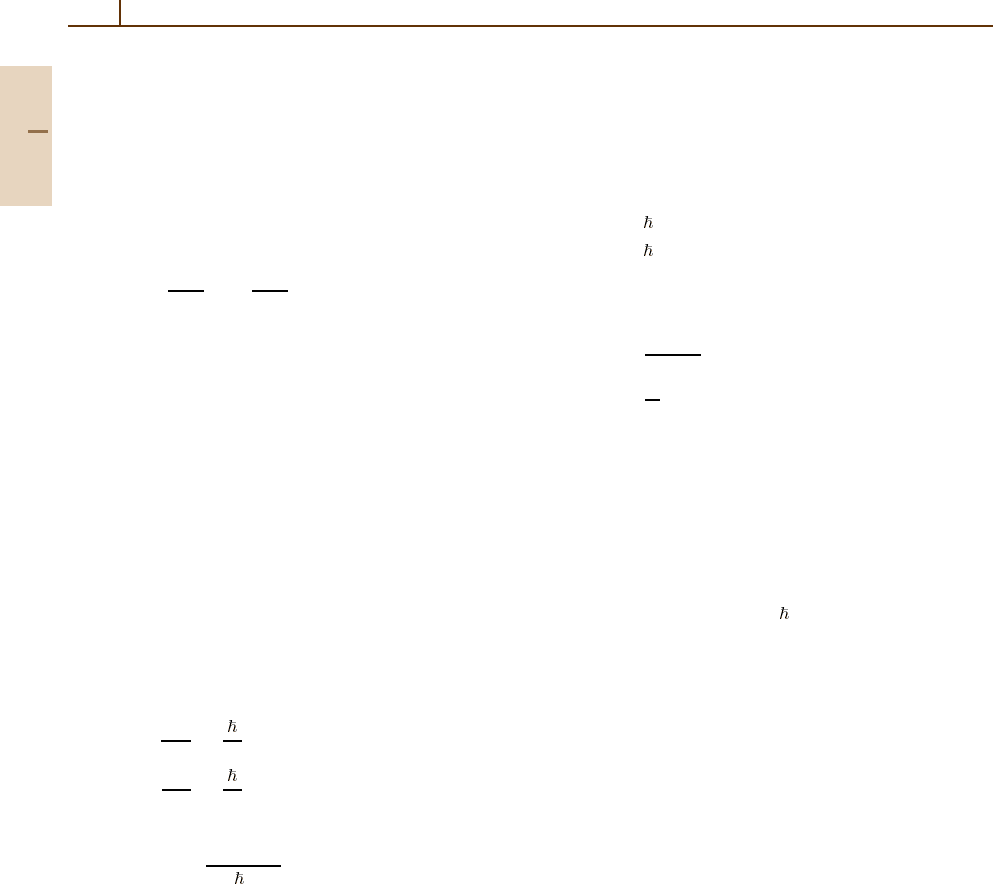
1074 Part F Quantum Optics
the ground state |g if Ω
a
= 0. Thus if Ω
b
is turned
on first, and then Ω
a
turned on later, the ground state
adiabatically becomes the trapping state and all initial
probability flows smoothly with it.
An essential point is the ease with which pump-
probe adiabaticity is maintained, particularly for strong
fields on resonance, in contrast to one-photon adiabatic-
ity, which is never achieved at strong-field resonance. In
the pump-probe case one must only satisfy the inequality
dΩ
a
dt
Ω
b
−
dΩ
b
dt
Ω
a
Ω
2
a
+Ω
2
b
3/2
, (73.40)
which is automatically accomplished by counter-
intuitive pulse sequencing. The inequality allows one
to tolerate rapid change of Ω
b
while Ω
a
= 0. Then af-
ter Ω
b
has reached a high value, Ω
a
can also be turned
on very rapidly because the right side of (73.40)isal-
ready very large. This is “counter-intuitive” excitation
because if the population is in level |g it is “natural”
to turn on pulse Ω
a
first, not Ω
b
. It can be dramatically
beneficial to use counter-intuitive excitation when it is
important to avoid relaxation associated with level |2.
73.6.4 Three-Level Transparency
The foregoing results for three-level excitation can be
extended to resonant pulse propagation in three-level
media. The equations governing simultaneous two-pulse
evolution in the local-time coordinates cT ≡ ct −z and
ζ ≡ z are
∂E
a
∂ζ
= i
d
a
µ
a
a
∗
g
b
2
,
∂E
b
∂ζ
= i
d
b
µ
b
a
∗
e
b
2
, (73.41)
where
µ
a
=
4πd
2
a
Nω
a
c
, etc.
(73.42)
Note that the bilinear combination 2a
∗
g
b
2
corresponds to
U −iV in (73.16).
Soliton-like pulses can propagate in three-level me-
dia. Both pulses must compete for interaction with level
|2. They depend only on a single variable Z ≡ ζ −uT
where u is the pulse’s constant velocity in the moving
frame. Soliton solutions are given (for µ
a
= µ
b
)forΛ
media by
E
a
= /d
a
= A sech KZ ,
E
b
= /d
b
= B tanh KZ , (73.43)
and
a
g
=−tanh KZ
b
2
=
−2iKu
A
sech KZ ,
(73.44)
a
e
=
B
A
sech KZ ,
where the parameters A, B, Ku are nonlinearly related
to the pulse length τ:
Ku ≡ 1/τ and
2/τ
2
= A
2
− B
2
. (73.45)
The moving frame velocity is given by 1/u = 2µ/A
2
and the expression for the lab frame velocity V is 1/V =
1/c +2µ/ A
2
.
If B →0, then E
a
→
2 /τd
a
sechKZ, which is the
exact McCall–Hahn formula for the two-level one-pulse
soliton amplitude [73.1]. No adiabatic condition was in-
voked in obtaining the soliton solutions. The physical
measure of adiabaticity comes from the pulse duration
τ.Ifτ is short, an appreciable population appears tran-
siently in level |2,butifτ is long (an adiabatic pulse),
the population skips level |2 and goes directly from |g
to |e and back again during the pulse.
Note that the sech and tanh functions are ideally
counter-intuitive, with pulse b starting infinitely far
ahead of pulse a. In practice, the infinite leading edge of
the tanh function plays no role and can be truncated to
several times τ without appreciable change in the char-
acter of the pulse pair.
73.7 Disentanglement and “Sudden Death” of Coherent Transients
The existence of entanglement (non-separability) of
states is the most prominent evidence that quantum me-
chanics is a truly nonlocal theory. This has consequences
for coherent transients, allowing them to exhibit non-
intuitive effects unlike any discussed up to this point.
We will choose an example that directly illustrates this
point by showing that two entangled atoms whose in-
version and coherence decay exponentially can have an
entanglement that not only does not decay exponen-
tially but which reaches its steady state long before
the atoms reach their final states. In this sense the
nonlocal transients of the pair of atoms are not at all
Part F 73.7

Coherent Transients 73.7 Disentanglement and “Sudden Death” of Coherent Transients 1075
intuitively related to the local transients affecting the
atoms separately.
We imagine the situation sketched in Fig. 73.8,
two two-level atoms A and B of the type discussed
at length already, prepared in a partially excited en-
tangled mixed state and located remotely from each
other, without direct or indirect interaction. They each
must eventually, because of spontaneous emission, come
to their ground states, creating the final joint state
|−
A
⊗|−
B
, which is clearly in factored form (disen-
tangled). The question is, what is the manner of evolution
by which the quantum entanglement feature evolves
toward zero.
The standard Master Equation methods [73.12]
for investigating spontaneous emission [73.13] can be
applied to each atom separately since they are not inter-
acting with each other. For any initial state ρ
AB
(0),the
density operator at t can be expressed as
ρ
AB
(t) =
4
µ=1
K
µ
(t)ρ
AB
(0)K
†
µ
(t), (73.46)
where the so-called Kraus operators [73.14] K
µ
(t) are
available in closed form in this case [73.15].
For illustration we will choose a partially coherent
initial state, expressed by a two-atom density matrix with
a single free parameter a:
ρ
AB
(0) =
1
3
a 00 0
011 0
011 0
0001−a
.
(73.47)
Here the convention is to label the rows and columns
in the order ++, +−, −+, −−. The transient decay
of either atom’s excitation can be calculated separately
from their reduced density matrices ρ
A
≡Tr
B
{ρ
AB
},etc.
For example:
ρ
A
=+
B
|ρ
AB
|+
B
+−
B
|ρ
AB
|−
B
=
1
3
1 +a 0
02−a
,
(73.48)
and the upper level excitation of atom A can
be found to behave exactly as expected: ρ
A
++
(t) =
a+1
3
e
−t/τ
0
,whereτ
0
is the usual spontaneous emission
lifetime.
For nonlocal transients we will need a time-
dependent measure of entanglement, and there are
several options [73.16], all related to the joint entropy of
the two-atom system. We will use the concurrence C(t)
Atom A Atom B
Cavity A Cavity B
Fig. 73.8 Illustration of a set-up in which two partially
excited atoms A and B are located inside two spatially
separated cavities that are possibly very remote from each
other. The two atoms are assumed initially entangled, but
they have no interaction
of Wootters [73.17], which has the convenient normal-
ization 1 ≥C(t) ≥ 0, where C =1 represents completely
entangled atoms (such as in a pure Bell state, for ex-
ample) and C = 0 denotes the complete absence of
entanglement.
For the specific case a = 1 one finds for the state
(73.47) the initial concurrence C(0) =
2
3
, indicating a
state with partial two-party coherence (incomplete en-
tanglement). At time t one then finds:
C
AB
(t) =
2
3
max
0, e
−t/τ
0
f(t)
, (73.49)
where f(t) = 1 −
√
2ω
2
+ω
4
, and ω ≡ 1 − e
−t/τ
0
.The
strikingly non-intuitive consequence of this expression
is that C(t) → 0 abruptly after a short time (disentan-
glement suffers a “sudden death”) if 2ω
2
+ω
4
≥ 1. In
fact, only a minor algebraic rearrangement shows that
this strange condition must occur, and the finite sudden
1
2
⁄
3
1
⁄
3
0
0.5
1
0.5
2
2.5
3
2
⁄
3
1
⁄
3
0
t
ρ
C( )
a
Fig. 73.9 Effect of spontaneous emission on concurrence
of two two-level atoms given the initially entangled mixed
state (73.47) depending on the single parameter 1 ≥ a ≥ 0
Part F 73.7

1076 Part F Quantum Optics
death time t
0
is given by
t
0
τ
0
≡ ln
2 +
√
2
2
≈ 0.53 .
(73.50)
The non-local coherent transient behavior of entangle-
ment for the entire range of allowed a values [73.15]is
shown in Fig. 73.9. This shows that the concurrence un-
dergoes familiar smooth and infinitely long decay only
for a values in the limited range
1
3
> a ≥ 0. Otherwise
sudden death occurs sooner or later. In our example,
non-local coherence becomes zero most abruptly after
a finite time for a = 1, the case that was calculated in
(73.49). Although not yet observed experimentally, it
appears that these results are not exceptional. Sudden
termination of entanglement has also been predicted for
two-party continuum states as well as for qubit pairs ex-
periencing only T
2
decay, in contrast to the combined
T
1
and T
2
decay appropriate to spontaneous emission as
treated here.
References
73.1 L. Allen, J. H. Eberly: Optical Resonance and Two-
Level Atoms (Dover, New York 1987)
73.2 B. W. Shore: Theory of Coherent Atomic Excitation,
Vol. 1,2 (Wiley, New York 1990)
73.3 P. Meystre, M. Sargent III: Elements of Quantum
Optics (Springer, Berlin, Heidelberg 1990)
73.4 C. Cohen-Tannoudji, J. Dupont-Roc, G. Grynberg:
Atom-Photon Interactions (Wiley, New York 1992)
73.5 M. O. Scully, M. S. Zubairy: Quantum Optics (Cam-
bridge Univ. Press, Cambridge 1997)
73.6 W. P. Schleich: Quantum Optics in Phase Space
(Wiley-VCH, New York 2001)
73.7 C. C. Gerry, P. L. Knight: Introductory Quantum Op-
tics (Cambridge Univ. Press, Cambridge 2005)
73.8 P. W. Milonni, J. H. Eberly: Lasers (Wiley, New York
1988)
73.9 M. V. Fedorov: Atomic and Free Electrons in a Strong
Light Field (World Scientific, Singapore 1997)
73.10 J. D. Jackson: Classical Electrodynamics, 2nd edn.
(Wiley, New York 1975)
73.11 F. H. M. Faisal: Theory of Multiphoton Processes
(Plenum, New York 1987)
73.12 See Sect. 78.7 in this book
73.13 See Sect. 78.12 in this book
73.14 A complete discussion of Kraus operators appropri-
ate to Bloch vector evolution is given in S. Daffer,
K. W
´
odkiewicz, J. K. McIver: J. Mod. Optics 51,1843
(2004)
73.15 Ting Yu, J. H. Eberly: Phys. Rev. Lett. 93, 140404
(2004)
73.16 See Chapt. 81 in this book
73.17 W. K. Wootters: Phys. Rev. Lett. 80, 2245 (1998)
Part F 73

1077
Multiphoton a
74. Multiphoton and Strong-Field Processes
The excitation of atoms by intense laser pulses can
be divided into two broad regimes: the first regime
involves relatively weak optical laser fields of long
duration, and the second involves strong fields
of short duration. In the first case, the intensity
is presumed to be high enough for multiphoton
transitions to occur. The resulting spectroscopy is
not limited by the single-photon selection rules
for radiative transitions. However, the intensity
is still low enough for a theoretical description
based on perturbations of field-free atomic states
to be valid, and the time dependence of the
field amplitude does not play an essential role.
In the second case, the field intensities are too
large to be treated by perturbation theory, and
thetimedependenceofthepulsemustbetaken
into account. A discussion on the generation of
sub-femtosecond pulses is included.
74.1 Weak Field Multiphoton Processes ........1078
74.1.1 Perturbation Theory...................1078
74.1.2 Resonant Enhanced
Multiphoton Ionization..............1078
74.1.3 Multi-Electron Effects ................ 1079
74.1.4 Autoionization..........................1079
74.1.5 Coherence and Statistics ............ 1079
74.1.6 Effects of Field Fluctuations ........1079
74.1.7 Excitation with Multiple
Laser Fields .............................. 1080
74.2 Strong-Field Multiphoton Processes ......1080
74.2.1 Nonperturbative Multiphoton
Ionization ................................1081
74.2.2 Tunneling Ionization ................. 1081
74.2.3 Multiple Ionization.................... 1081
74.2.4 Above Threshold Ionization ........ 1081
74.2.5 High Harmonic Generation ......... 1082
74.2.6 Stabilization of Atoms
in Intense Laser Fields ............... 1083
74.2.7 Molecules in Intense
Laser Fields .............................. 1084
74.2.8 Microwave Ionization
of Rydberg Atoms ......................1084
74.3 Strong-Field Calculational Techniques ... 1086
74.3.1 Floquet Theory..........................1086
74.3.2 Direct Integration of the TDSE .....1086
74.3.3 Volkov States ............................1086
74.3.4 Strong Field Approximations....... 1087
74.3.5 Phase Space Averaging Method ... 1087
References .................................................. 1088
The excitation of atoms by intense laser pulses can
be divided into two broad regimes determined by the
characteristics of the laser pulse relative to the atomic
response. The first regime involves relatively weak op-
tical laser fields of long duration (> 1 ns), and the second
involves strong fields of short duration (< 10 ps). These
will be referred to as the weak-long (WL) and strong-
short (SS) cases respectively.
In the case of atomic excitation by WL pulses, the
intensity is presumed to be high enough for multiphoton
transitions to occur. The resulting spectroscopy of ab-
sorption to excited states is potentially much richer
than single-photon excitation because it is not lim-
ited by the single-photon selection rules for radiative
transitions. However, the intensity is still low enough
for a theoretical description based on perturbations of
field-free atomic states to be valid, and the time depen-
dence of the field amplitude does not play an essential
role.
The SS case is fundamentally different in that the
atomic electrons are strongly driven by fields too large
to be treated by perturbation theory, and the time depen-
dence of the pulse as it switches on and off must be taken
into account. Atoms may absorb hundreds of photons,
leading to the emission of one or more electrons, as well
as photons of both lower and higher energy. Because
the flux of incident photons is high, a classical descrip-
tion of the laser field is adequate, but the time dependent
Schrödinger equation (TDSE) must be solved directly
to obtain an accurate representation of the atom–field
interaction.
For SS pulses of optical wavelength, it is sufficient
in most cases to consider only the electric dipole (E1)
interaction term defined in Chapt. 68. The atom–field
Part F 74
